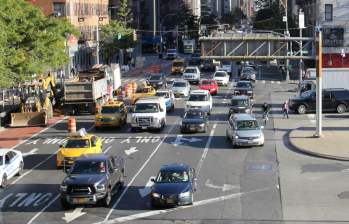TransAlt: De Blasio Needs to Ramp Up Protected Bike Lanes to Make More New Yorkers Feel at Ease on a Bike
The current rate of protected bike lane installation is not sufficient to meet the mayor's goal of doubling cycling by 2020, TransAlt says in a new report.

Mayor de Blasio needs to accelerate the installation of protected bike lanes in his second term to achieve his goal of doubling cycling by 2020, Transportation Alternatives says in a new report, BikeNYC 2020 [PDF].
In 2013, the de Blasio administration committed to doubling cycling rates in NYC by 2020. While the number of cycling New Yorkers has increased under de Blasio, progress has slowed according to some measures, and the city not kept pace with the mayor’s stated goal.
To better understand what’s holding people back from biking more, TransAlt surveyed 6,186 New Yorkers. The web survey, which was not a random sample, focused primarily on gathering feedback from people who bike.

Concern about physical safety was the primary factor discouraging more frequent cycling. Among participants who used to bike but stopped, 71 percent said they did so because drivers made them feel unsafe; 12 percent stopped after a collision or other “harrowing incident”; and 99 percent said more protected bike lanes would encourage them to ride again.
Even among self-described frequent cyclists, 88 percent expressed concerns about getting hit by drivers.
Among the 14 percent of respondents who haven’t started riding, four out of five said “fear of drivers” was holding them back, two-thirds “mentioned the lack of protected bike lanes making them feel unsafe.”
The current rate of protected bike lane installation is not sufficient to double the number of New Yorkers who feel at ease biking on city streets. Of the 83 new miles of bike lanes installed during Fiscal Year 2016-2017, only 20 percent were protected bike lanes, according to the report. In that same span, the city resurfaced 1,321 miles of roads, rarely if ever using the opportunity to claim street space for bicycling.
The report outlines a set of steps for the de Blasio administration to attain its 2020 bicycle mode share goal. Among the recommendations:
- Guarantee that every New Yorker lives within a quarter-mile of a protected bike lane;
- Include protected bike lanes in every major street redesign;
- Installing safe bicycle connections on bridges that currently lack them;
- Test out cycle superhighways, as well as protected intersections, and car-free streets;
- Expand bike-share to all five boroughs;
- End the NYPD’s crackdown on commercial cyclists and ticketing of minor cycling infractions, which discourage cycling;
- Increase bicycle parking;
- Passing a bill to exempt the city’s “Vision Zero Priority Corridors” from Local Law 61 of 2011, which requires community board hearings on any bike lane projects.




